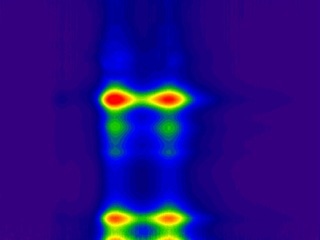Oct 17 2019
In trions, three charged particles are bonded together by very weak bonding energy. In applications like electronics and quantum computing, trions can potentially carry more information compared to electrons.
 A UMD-led team of researchers has developed a method to trap trions at room temperature in single-walled carbon nanotubes. In this photoluminescence spectroscopy image, trapped trions and excitons can be seen as bright red spots against the dark blue background emissions from the host nanotube. This new work makes it possible to manipulate quasiparticles such as trions and study their fundamental properties in ways that have never been possible before. (Image credit: Hyejin Kwon)
A UMD-led team of researchers has developed a method to trap trions at room temperature in single-walled carbon nanotubes. In this photoluminescence spectroscopy image, trapped trions and excitons can be seen as bright red spots against the dark blue background emissions from the host nanotube. This new work makes it possible to manipulate quasiparticles such as trions and study their fundamental properties in ways that have never been possible before. (Image credit: Hyejin Kwon)
However, trions are often unstable at room temperature, and the bonds between trion particles are very weak and disintegrate rapidly. A majority of the studies on trions necessitate supercooled temperatures; yet, their fleeting characteristic has rendered trions challenging to control and difficult to study.
A research team led by the University of Maryland has come up with a technique for reliable synthesis and trapping of trions that remain stable at room temperature. The study enables the trions to be manipulated and allows their fundamental properties to be explored.
The study has been reported in a research article published in the ACS Central Science journal on October 16th, 2019.
This work makes synthesizing trions very efficient and provides a method for manipulating them in ways we haven’t been able to before. With the ability to stabilize and trap trions, we have the potential to build a very clean system for studying the processes governing light-emitting diodes and photovoltaics and for developing quantum information technologies.
YuHuang Wang, Study Senior Author and Professor of Chemistry and Biochemistry, University of Maryland
As part of the new research, Wang and his team employed a chemical reaction to induce defects on the surface of single-walled carbon nanotubes. The defects lead to depressions in the energy landscape of the nanotube’s conductive surface. These depressions can be regarded as wells into which flowing charged particles could fall and become trapped within.
After forming the defects, the researchers struck the nanotubes with photons and detected bright luminescence at defect sites. Each luminescence flash at a typical wavelength implies that a particle called an exciton and an electron were trapped at a defect site and bound together into a trion.
The excitons developed when the carbon nanotubes were struck by the photons. When a photon is absorbed by a carbon nanotube, an electron from the nanotube is transferred from the ground state to an excited state, which leaves behind a positively charged hole. The electron and the hole are tightly bound together, thus forming an electron-hole pair known as an exciton.
The scientists stated that when one electron and one exciton fall into a well formed by the chemical defect, they bond with each other and create a trion that consists of one hole and two electrons. When the trion decays, it emits a photon, leading to the bright luminescence observed by the researchers.
It’s almost like bringing atomic physics into a chemistry lab. because the well resulting from the chemical defect functions as a kind of atomic-scale beaker for one single ‘bonding’ event. What is very exciting, is that the energy level of the trion is dictated by the well, and we can use chemical reactions to manipulate the well. This means we can potentially control the energy and stability of trions.
YuHuang Wang, Study Senior Author and Professor of Chemistry and Biochemistry, University of Maryland
According to Wang, the electron spin, charge, and other properties of the trions trapped by the chemical defect formed on the surface of the nanotube can be precisely manipulated by modifying the properties of the defect.
The trapped trions observed by Wang and his team in this study were more than seven times brighter compared to the brightest trions ever observed. Moreover, compared to free trions, they lasted more than 100 times longer.
Wang and his colleagues plan to continue advancing their technique for achieving precise control of the synthesis of trions at intentionally developed defects on carbon nanotubes and to study the basic optical and photophysics properties of trions.
The potential to reliably develop stable trions with particular properties will have wide significance for technologies like energy harvesting, bioimaging, solid-state computing, chemical sensing, and quantum computing.
It is interesting that a defect is not always negative, and in our case, could lead to entirely new ways of generating trions and conducting fundamental research on these quasi-particles.
Hyejin Kwon, Study Lead Author, University of Colorado
Kwon (Ph.D. ’16, chemistry), who is now pursuing her postdoctoral research at the University of Colorado, co-led the study with Mijin Kim (Ph.D. ’18, chemistry). Kim is now a postdoctoral fellow at Memorial Sloan Kettering Cancer Center.